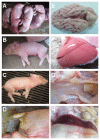Emergence of highly virulent pseudorabies virus in southern China
- PMID: 26130855
- PMCID: PMC4445515
Emergence of highly virulent pseudorabies virus in southern China
Abstract
Pseudorabies has been controlled efficiently in China for many years by vaccination. However, it suddenly broke out in many pig farms in 2012-2013 in southern China. In this study, a systematic investigation that included virus isolation, genetic and pathological studies, and immunogenicity analysis was carried out with the aim of understanding the pathogenetic and antigenic features of novel isolates of pseudorabies virus (PRV). Of 38 tissue samples collected from pigs with clinical signs of pseudorabies on 13 farms in 4 provinces in southern China in 2012-2013, 29 showed wild-type PRV infection by polymerase chain reaction. Sequence analysis of 5 isolates from the 4 provinces showed that they belonged to a relatively independent cluster that shared 2 insertions of a single amino acid in the gE gene and 1 insertion of 7 amino acids in the gC gene. In experiments, isolate ZJ01 caused death in 100% of pigs that were either 14 or 80 days old. The serum antibodies to the commercial PRV vaccines had significantly lower neutralizing activity against the ZJ01 isolate than against the vaccine strains. The antigenic relatedness between ZJ01 and the vaccine strains was 0.378 to 0.455. These findings indicated that a novel, highly virulent PRV strain with antigenic variance had spread widely in southern China.
La pseudorage a été maitrisée de manière efficace en Chine pendant plusieurs années grâce à la vaccination. Toutefois, en 2012–2013 des poussées de cas sont apparues soudainement dans des fermes porcines dans le sud de la Chine. Dans la présente enquête, l’isolement viral, des études génétiques et pathologiques, et des analyses d’immunogénicité furent effectués avec l’objectif de comprendre les caractéristiques pathogénétiques et antigéniques des nouveaux isolats du virus de la pseudorage (VPR). À partir de 38 échantillons de tissu prélevés en 2012–2013 chez des porcs avec des signes cliniques de pseudorage provenant de 13 fermes dans quatre provinces du sud de la Chine, 29 se sont révélés positifs par réaction d’amplification en chaîne par la polymérase pour une infection par une souche sauvage du VPR. L’analyse de séquence de cinq isolats provenant des quatre provinces montrait qu’ils appartenaient à un regroupement relativement indépendant qui partageait deux insertions d’un acide aminé unique dans le gène gE et une insertion de sept acides aminés dans le gène gC. Lors d’expériences, l’isolat ZJ01 causait la mort chez 100 % des porcs qui étaient âgés de 14 ou 80 jours. Les anticorps sériques envers les vaccins VPR commerciaux avaient une activité neutralisante significativement moindre contre l’isolat ZJ01 que contre les souches vaccinales. La parenté antigénique entre ZJ01 et les souches vaccinales variait de 0,378 à 0,455. Ces trouvailles indiquent qu’une souche nouvelle et hautement virulente du VPR avec une variance antigénique s’est répandue largement dans le sud de la Chine.(Traduit par Docteur Serge Messier).
Figures





Similar articles
-
[Investigation of etiology of massive infection with porcine pseudorabies virus in Henan and neighboring Provinces].Bing Du Xue Bao. 2014 Jul;30(4):441-9. Bing Du Xue Bao. 2014. PMID: 25272601 Chinese.
-
Polymorphisms affecting the gE and gI proteins partly contribute to the virulence of a newly-emergent highly virulent Chinese pseudorabies virus.Virology. 2018 Jun;519:42-52. doi: 10.1016/j.virol.2018.03.024. Epub 2018 Apr 7. Virology. 2018. PMID: 29631175
-
Emergence of a novel pathogenic recombinant virus from Bartha vaccine and variant pseudorabies virus in China.Transbound Emerg Dis. 2021 May;68(3):1454-1464. doi: 10.1111/tbed.13813. Epub 2020 Sep 8. Transbound Emerg Dis. 2021. PMID: 32857916
-
Pseudorabies virus infections in pigs. Role of viral proteins in virulence, pathogenesis and transmission.Vet Res. 1997;28(1):1-17. Vet Res. 1997. PMID: 9172836 Review.
-
Pseudorabies virus in wild swine: a global perspective.Arch Virol. 2011 Oct;156(10):1691-705. doi: 10.1007/s00705-011-1080-2. Epub 2011 Aug 12. Arch Virol. 2011. PMID: 21837416 Review.
Cited by
-
Postweaning mortality in commercial swine production II: review of infectious contributing factors.Transl Anim Sci. 2020 May 4;4(2):txaa052. doi: 10.1093/tas/txaa052. eCollection 2020 Apr. Transl Anim Sci. 2020. PMID: 32705048 Free PMC article. Review.
-
Construction and Immunogenicity of a Recombinant Pseudorabies Virus Variant With TK/gI/gE/11k/28k Deletion.Front Vet Sci. 2022 Jan 25;8:797611. doi: 10.3389/fvets.2021.797611. eCollection 2021. Front Vet Sci. 2022. PMID: 35146013 Free PMC article.
-
Construction of a quadruple gene-deleted vaccine confers complete protective immunity against emerging PRV variant challenge in piglets.Virol J. 2022 Jan 25;19(1):19. doi: 10.1186/s12985-022-01748-8. Virol J. 2022. PMID: 35078501 Free PMC article.
-
The recombinant pseudorabies virus expressing porcine deltacoronavirus spike protein is safe and effective for mice.BMC Vet Res. 2022 Jan 4;18(1):16. doi: 10.1186/s12917-021-03115-1. BMC Vet Res. 2022. PMID: 34983523 Free PMC article.
-
Detection of suid herpesvirus 1 infectivity in pigs by propidium monoazide-qPCR.Front Vet Sci. 2022 Oct 28;9:975726. doi: 10.3389/fvets.2022.975726. eCollection 2022. Front Vet Sci. 2022. PMID: 36387378 Free PMC article.
References
-
- Bouma A. Determination of the effectiveness of pseudorabies marker vaccines in experiments and field trials. Biologicals. 2005;33:241–245. - PubMed
-
- Hahn EC, Fadl-Alla B, Lichtensteiger CA. Variation of Aujeszky’s disease viruses in wild swine in USA. Vet Microbiol. 2010;143:45–51. Epub 2010 Feb 11. - PubMed
Publication types
MeSH terms
Substances
LinkOut - more resources
Full Text Sources
Miscellaneous
